Don't ignore the big-time importance of choosing the right small bone power tools for your upper and lower extremity surgeons. Here are some of the factors you need to consider when shopping the options.
- Ergonomics. The most important factor for your surgeons is how a particular power tool feels, how it operates, how it behaves. Think of it like how an athlete or musician feels about a particular model of baseball glove or guitar. Likewise, don't assume that any given small bone power tool is "one-size-fits-all."
Surgeons will know pretty quickly whether a power tool feels right in their hand. Is it their preferred weight? How easy is it to grip? How easy is it to control? Does it feel well-balanced? When surgeons begin drilling, is the speed and power what they expect and require? Remember, different surgeons have different hand sizes and different styles. You want them to feel the maximum amount of comfort and confidence in the tool they're using.
- Power. Traditionally, small bone power tools needed to be plugged into a power source. Now battery-operated tools offer surgeons a lot more freedom of movement and maneuverability, reduce clutter and cabling snafus.
However, the freedom provided by cordless tools comes at a price: You need to make sure that at any given time you'll have enough tools charged up, so surgeries aren't delayed. When evaluating your options, look at how long each one holds a charge, and how long it takes to recharge. The tool should have a battery power indicator as well. Also keep in mind that with some cordless systems, the battery isn't autoclavable, so it's unsterile. You open the back of the tool, and drop the battery in there.
- Attachments. This one's pretty straightforward: Does the tool accommodate all of the types and sizes of attachments such as drills and wire drivers that your surgeons need to perform their surgeries? Most will, but you need to confirm with your surgeons and the vendor. Many tools also include universal adapters for increased versatility.
- Durability. It's hard to gauge how long these power tools will last without needing to be repaired or discarded. Honestly, I don't know if durability ultimately is representative of the product itself or the surgeons who are using them. It's not like we're gentle with these tools in the OR. As any surgeon will tell you, when we pull the trigger and the tool won't run, almost universally we'll ask for a mallet to hit it on the side to hopefully kick it into gear. Make sure there's enough of a supply of these tools in the OR that when one doesn't work, another one is ready to go. If necessary, arrange for loaners or demo units to use if no others are available.
- Smarter tools. Some newer tools provide feedback that can increase a surgeon's accuracy. Take plunge, for example. When surgeons want to drill through bone without inadvertently "plunging" into good tissue, they benefit from getting feedback about when to stop drilling. I've seen drills that automatically stop when you've reached the end of bone and are about to drill into tissue. It's really neat technology, but it doesn't have widespread adoption yet because it's cost prohibitive. If these more intelligent tools were similar in cost to regular drills, I think they'd be used almost universally. For now, know that experienced surgeons are well-versed in measuring depth manually. I'm not certain the added cost of these high-end tools is worth it when surgeons can take an extra 10 seconds to measure bone depth themselves.
Bottom line: There are many types of these vital surgical tools available, but each of your surgeons should trial the options and share their preferences before you buy. Never try to talk surgeons into using tools they don't feel fully confident about using. OSM
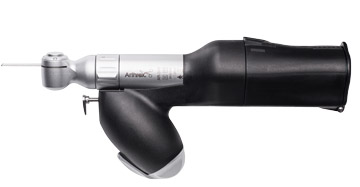 ?
?Arthrex
DrillSaw Mini 300 System
800-933-7001
Price: not provided
FYI: The modular design of this cordless tool consists of a single handpiece and is touted by the company for its cost-effectiveness, ergonomics and precision. It features a proprietary brushless motor, PEEK housing
(known for being durable in punishing environments) and washer/decontaminator compatibility for easy cleaning. Available attachments allow for drilling, reaming, burring, sagittal sawing and reciprocal sawing/burring. The tool
runs on a powerful, rechargeable lithium-ion battery designed to provide plenty of power and endurance. A universal adaptor changing system lets surgeons easily switch attachments for all types of small bone surgeries.
 ?
?BioAccess
BioAccess Small Bone Tool
877-593-9966
Price: not provided
FYI: Here's a slick, single-use small bone tool that eliminates worries about reprocessing, repairs or replacing batteries. It's packaged in a specially designed sterile tray, within a sterile pouch. Before use,
the surgeon simply inserts a non-sterile motor through into the tool's handle and locks it into place, then removes the tool from the tray. The company claims that once the reusable motor is encapsulated, it can't be contaminated
or contaminate the tool. At the end of surgery, the surgeon places the tool back in the tray, removes the motor and closes the tray. The tray with the contaminated tool is thrown away, while the motor is immediately ready for reuse.
Collet, quick release and keyless chuck attachments are packaged separately in sterile pouches; only the attachment that's needed must be opened.
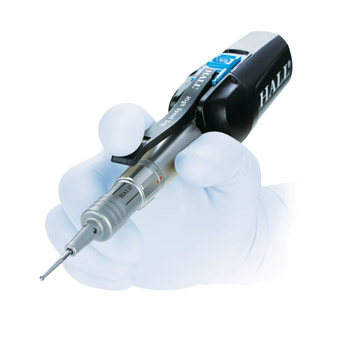 ?
?ConMed
Hall MicroFree System
800-237-0169
Price: not provided
FYI: This cordless small bone power system is backward-compatible with all of the company's highspeed pencil-grip handpieces. The system comes with 5 handpieces (sagittal, oscillating and reciprocating saws, and
high- and medium-speed drills), a mini-driver, a lithium power unit, a small lithium-ion battery and 2 customizable sterilization trays. The rechargeable battery is autoclavable and can be placed in the same tray as the handpieces
and attachments. ConMed designed the pencil-grip handpiece based on surgeon feedback, which resulted in adjustments in the tool's center of gravity to improve balance, stability and control while reducing muscle fatigue. Another
interesting twist: The sagittal saw head can be rotated in 45 ? increments for additional flexibility.
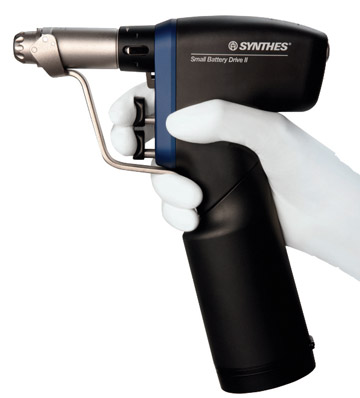 ?
?DePuy Synthes
Small Battery Drive II
800-327-6887
Price: not provided
FYI: This device requires only a single motor to perform most applications such as drilling, reaming and sawing. Powered by a lithium-ion battery, the vendor claims this new version improves upon its original Small
Battery Drive in terms of power, battery capacity and reliability. It offers a standing battery casing for increased convenience in the OR, a large portfolio of attachments for a broad range of applications and a dedicated washing
basket.
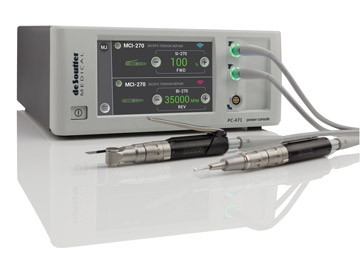 ?
?De Soutter Medical
osteodrive
866-655-9040
Price: not provided
FYI: De Soutter touts the versatility of these versatile handpieces, which are powered by a dual socket power supply, accommodate 11 different attachments and feature a mode selector that lets surgeons easily rotate
among forward, reverse and safety modes. Surgeons can control the tool's power with a detachable foot pedal or extendable finger lever that allows for optimal positioning of the tool. The company also highlights the choice of a
fully programable power console or a less expensive plug-and-play option.
 ?
?MicroAire Surgical Instruments
Series 5000 Small-Bone System
800-722-0822
Price: not provided
FYI: MicroAire claims the lightweight and compact Series 5000's Solo Driver is the smallest wire driver with the widest range of wire sizes available. Offering single-handed, fingertip control for forward, reverse
and oscillate, the device is fully cannulated, ambidextrous and touted for its ergonomic comfort that reduces hand fatigue in surgeons.
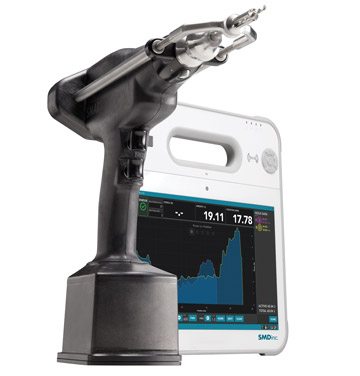 ?
?Smart Medical Devices (SMD)
SMARTdrill 6.0
888-73-SMART
Price: $74,500 for entire system, which includes 2 batteries, battery charger, 2 chucks, computer tablet and proprietary software.
FYI: It was only a matter of time before surgical drills could leverage digital connectivity in the interest of more efficient and accurate performance. SMARTdrill 6.0 is a prime example of what's likely to eventually
become the norm for extremity surgery — data-informed drilling. The idea is to take the guesswork out of drilling bone, selecting and inserting screws, and selecting implant hardware by measuring depth, torque and energy;
that information is collected by a sensor on the drill and transmitted via Bluetooth to a tablet the surgeon can view in real time. The company says SMARTdrill removes the need for conventional depth gauges and X-rays. Surgeons
can see if the autoclavable drill is dull or clogged, and are better able to stop drilling precisely when they're about to damage soft tissue.
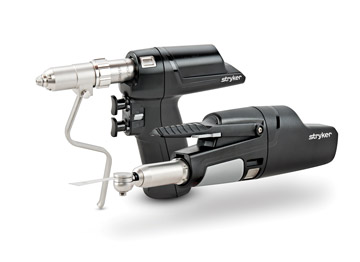 ?
?Stryker
F1 Small Bone Power System
800-253-3210
Price: not provided
FYI: The F1, billed as balanced and lightweight, is also cordless. Surgeons long bound by cord-and-console setups can feel much freer to maneuver, as well as less concerned about contaminating the sterile field
with dirty cords. Another cool feature: a choice of pencil- or pistol-style gripping via the F1's SmartGRIP lithium-ion battery control modules. Using either module, surgeons can operate 3 micro saws, a micro drill, and a universal
motor for inserting k-wires and drilling. The control modules can go unused for 30 days without losing power and performance, says the company. The F1 system features an all-inclusive, non-anodized container with 2 tray inserts
to hold all system components, and even contains insulation to increase resistance to thermal damage throughout sterilization.
.svg?sfvrsn=be606e78_3)
.svg?sfvrsn=56b2f850_5)